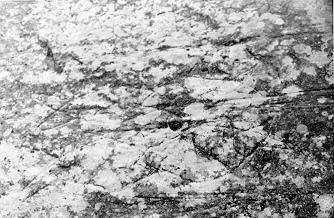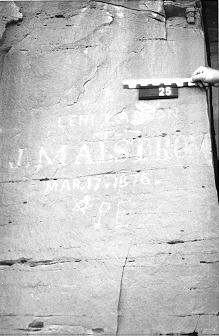
|
The Rocks Can Tellby William C. Suran |
|---|
The following story tells something about what the writing on the rock walls at House Rock Springs divulges.
The horses were tired and so were the men who rode them. It had been a hard day for both. The bearded men broke camp early that morning under leaden skies, fixed their meager breakfast, packed their belongings and headed east through a thick pine forest. The leaders of the expedition had drawn straws to determine if they would continue on their westward trek to seek the Pacific Ocean or turn back toward the Moqui Indian villages and home. The short straw determined they would head for home. The leader would never know all the straws had been clipped short.
The rain began early and turned to snow before noon. The horses bent their heads and trudged slowly through the forest. The men remained silent most of the way. For nearly a year they had traveled through the wilderness hoping to find a route to the Pacific Ocean, but failed.
By late that afternoon they reached the valley, the rain had stopped but the wind was cold and biting. Scouts sent ahead to reconnoiter the area reported a spring with fresh sweet water ahead. Here they camped and rested for several days. During this period they explored the valley and made their way back into a side canyon to the source of the spring. The wind had blown the clouds away but the winter chill hung on. On the ledge leading to the source of the spring fifty feet above the canyon floor a padre stopped, the rock wall before him was smooth. Only a little lichen grew on the upper part of the stone. "Give me your dagger," he said to the soldier with him. Asking no questions the armored man removed the steel weapon from his sash and handed it to the priest. Using the sharp point he scratched a drawing of four fish on the stone, two facing each other nose to nose, then repeated the drawing directly below. "A sign that Christians were here," he said and handed the knife to his associate. Both men crossed themselves and continued on. This was in November 1776. The men were Spanish and the leader of the expedition was Franciscan Silvestre Velez de Escalante.

|
The Spaniards left the marking on the rock behind. As time passed the lichen spread, covering two of the fish, almost obliterating them from view. Wind, sand and water helped to dim the drawing through the next eighty years.
The valley remained quiet and undisturbed. Only the Indians used the spring and as time passed a few wandering explorers or mountain men stopped to water their horses and fill their canteens before they continued on. Possibly they never noticed the fish high on the wall -- such things held little interest for them.
In 1858 Jacob Hamblin, an early Mormon explorer, came to the valley with orders from Brigham Young to visit the Hopi Villages. At least two of his men left their names on the wall, J. A. McConnell and William Maxwell. No record exists to say they noted the four fish -- probably not, because by now the lichen and erosion had dimmed the outline drawing more.
Traffic through the valley became steady by 1876 with the Mormon migrations to Arizona to settle along the Little Colorado River. Mormon history helps tell the story of many of those who scratched or carved their names. Bishop Lorenzo Roundy, who signed his name in what was now known as House Rock Valley gives a hint of what the rocks can tell. Bishop Roundy came on April 1, 1876. After leaving the valley he and his party made their way beneath the Vermilion Cliffs to Jacobs Pools. When they arrived at Lee's Ferry they found the river flooded. In spite of warnings by young Billy Lee, Jacob Hamblin, the leader of the expedition insisted on loading three wagons onto the flat-bottomed boat. In the middle of the river the boat capsized. They lost everything. Billy Lee's quick action saved all the men except Roundy. Before Billy could reach him the thick silt-laden water had sucked him under and carried him downstream.

|
By 1880 the Mormon people traveled both ways through the Valley. Young married people made their way back to St. George to seal their vows in the new temple. They carved their names in the fall of the year after the crops were in at home or on the return trip in the spring after the weather had turned better for traveling. The dates tell the story.
After the railroads spanned the nation travel through the area tapered off. In the early 1900's the names of a few visitors appear on the walls; some came to study what was there, some to deface and destroy. The four fish remain -- now nearly hidden under the lichen growth, but they are still there -- a reminder of 250 years of history.
******
Used by permission of the Grand Canyon Pioneers Society.
|
|
|---|
|
|---|